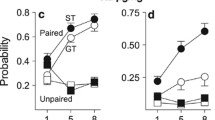Abstract
Schedule-controlled responding was maintained under a fixed-ratio schedule in mice. Administered alone, clonidine, morphine and naloxone produced dose-related decreases in rates of responding, with clonidine about 100 times more potent than morphine which was about ten times more potent than naloxone. Decreases in response rates produced by high doses of naloxone were antagonized by clonidine (0.003–0.1 mg/kg) in a dose-dependent manner; however, decreases in response rates produced by clonidine (0.3 mg/kg) were not antagonized by naloxone (1.0–100 mg/kg). Effects of high doses of naloxone (100 mg/kg) were not antagonized by morphine (1.0–100 mg/kg) whereas effects of morphine (17.0 mg/kg) were antagonized by naloxone (0.01–1.0 mg/kg). Thus, clonidine can reverse behavior-disrupting effects of naloxone in non-dependent subjects, indicating that at least some of the interactions of these two drugs are not specific to the opioid-dependent state.
Similar content being viewed by others
References
Botticelli L (1977) Some effects of morphine on schedule-controlled behavior in the mouse. Fed Proc 36:1044
Collier HOJ, Francis DL, Schneider C (1972) Modification of morphine withdrawal by drugs interacting with humoral mechanisms: some contradictions and their interpretation. Nature 237:220–222
Dunnett CW (1955) A multiple comparison procedure for comparing several treatments with a control. Am Stat Assoc J 50:1096–1121
Gellert VF, Holtzman SG (1979) Discriminative stimulus effects of naltrexone in the morphine-dependent rat. J Pharmacol Exp Ther 211:596–605
Jasinski DR, Johnson RE, Kocher TR (1985) Clonidine in morphine withdrawal: differential effects on signs and symptoms. Arch Gen Psychiatry 42:1063–1066
Katz JL (1984) Effects of clonidine and some alpha-adrenergic antagonists alone and in combination on schedule-controlled behavior in pigeons and mice. Psychopharmacology 83:38–43
Katz JL (1986) Effects of clonidine and morphine on opioid withdrawal in rhesus monkeys. Psychopharmacology 88:392–397
McCarthy DA (1959) Pharmacologic analysis of mechanisms in the morphine-dependent state. Unpublished Doctor of Philosophy Thesis, University of Michigan, Ann Arbor, Michigan
Sparber SB, Meyer DR (1978) Clonidine antagonizes naloxone-induced suppression of conditioned behavior and body weight loss in morphine-dependent rats. Pharmacol Biochem Behav 9:319–325
Tseng LF, Loh HH, Wei ET (1975) Effects of clonidine on morphine withdrawal in the rat. Eur J Pharmacol 30:93–99
Valentino RJ, Herling S, Woods JH (1983) Discriminative stimulus effects of naltrexone in narcotic-naive and morphine-treated pigeons. J Pharmacol Exp Ther 224:307–313
Vetulani J, Bednarczyk B (1977) Depression by clonidine of shaking behavior elicited by nalorphine in morphine-dependent rats. J Pharm Pharmacol 29:567–569
Young AM, Woods JH (1982) Limitations on the antagonistic actions of opioid antagonists. Fed Proc 41:2333–2338
Author information
Authors and Affiliations
Rights and permissions
About this article
Cite this article
Katz, J.L. Interactions of clonidine and naloxone on schedule-controlled behavior in opioid-naive mice. Psychopharmacology 98, 445–447 (1989). https://doi.org/10.1007/BF00441939
Received:
Accepted:
Issue Date:
DOI: https://doi.org/10.1007/BF00441939




